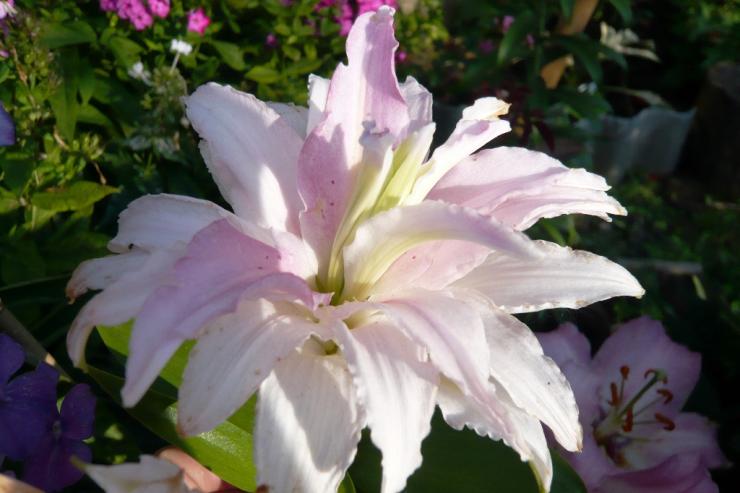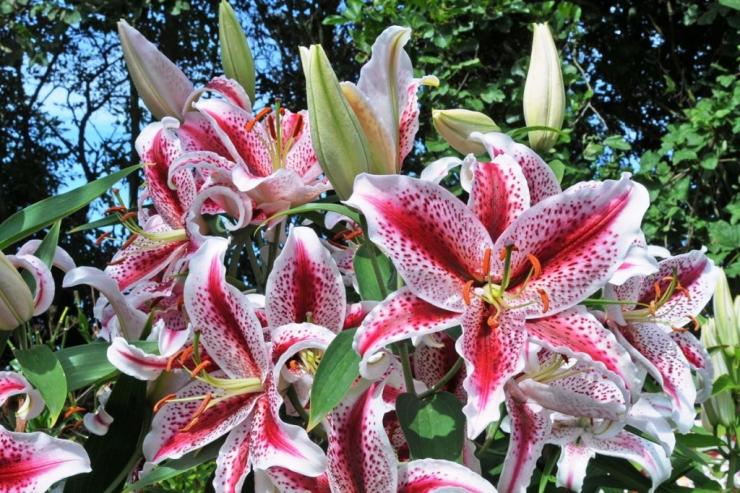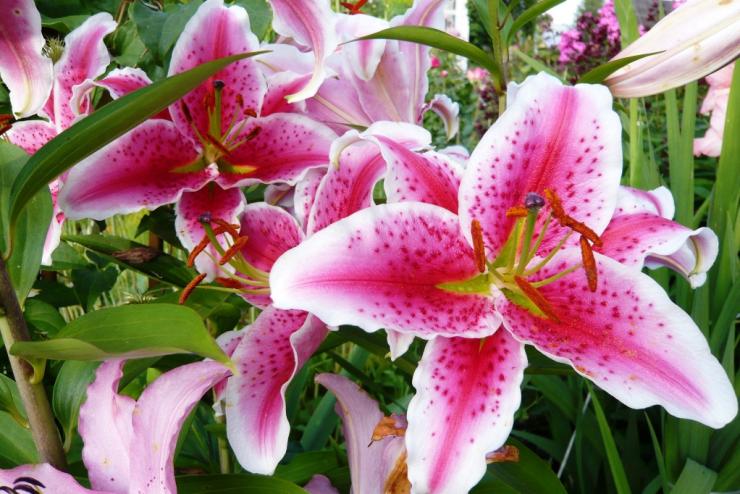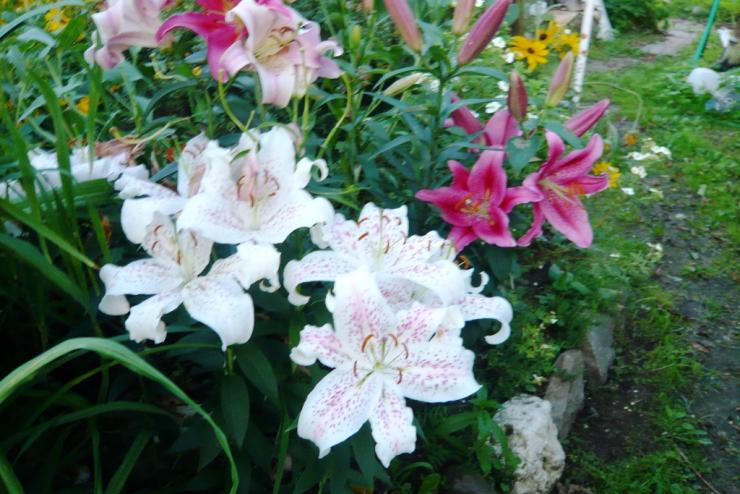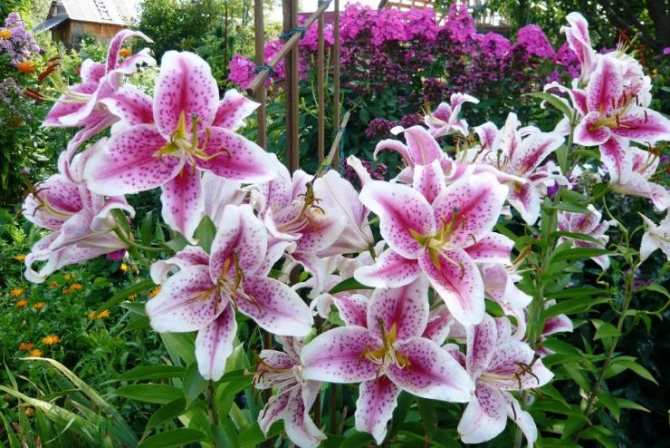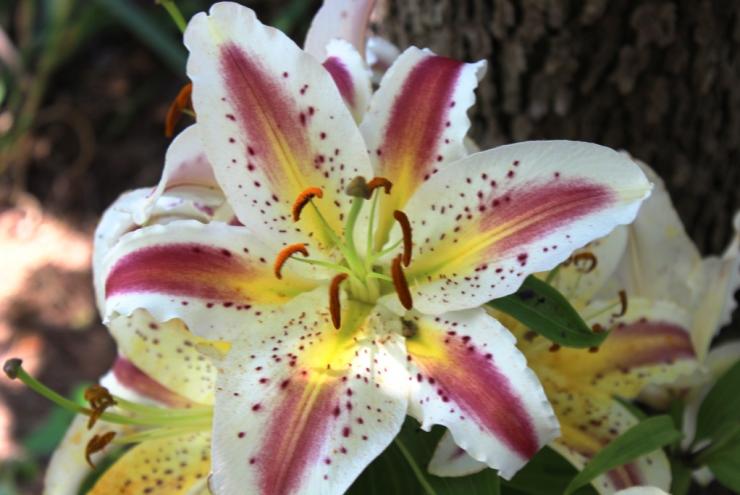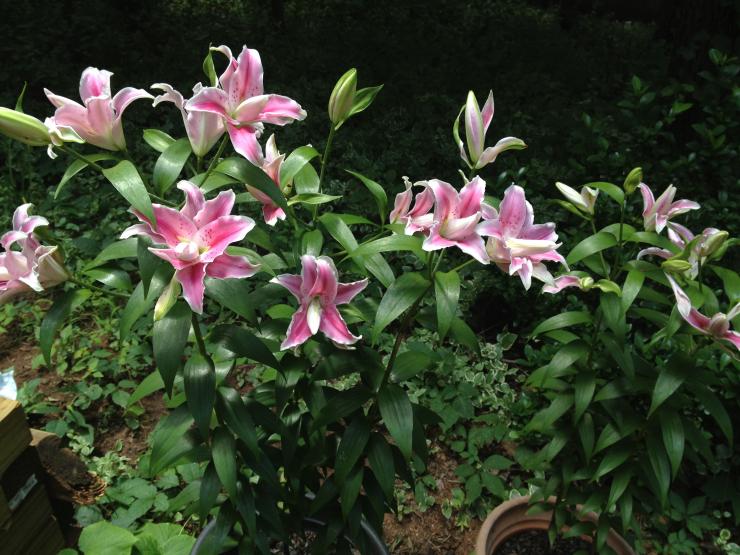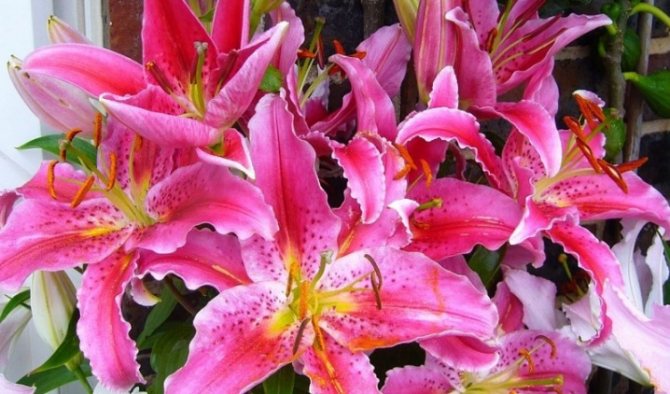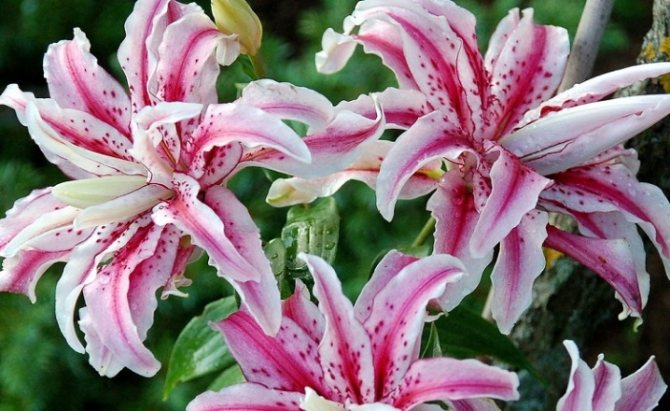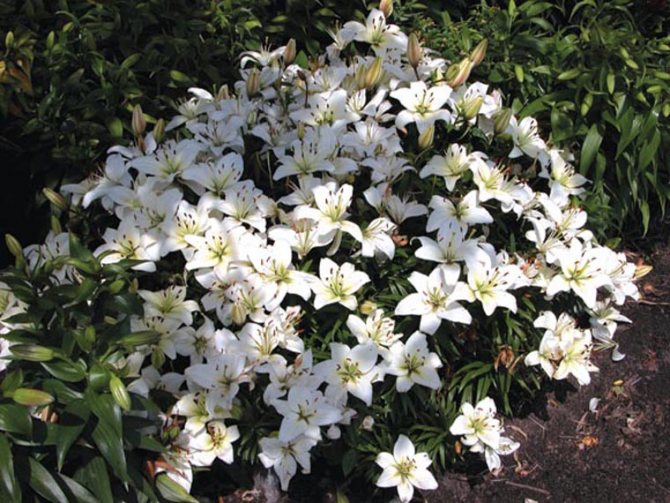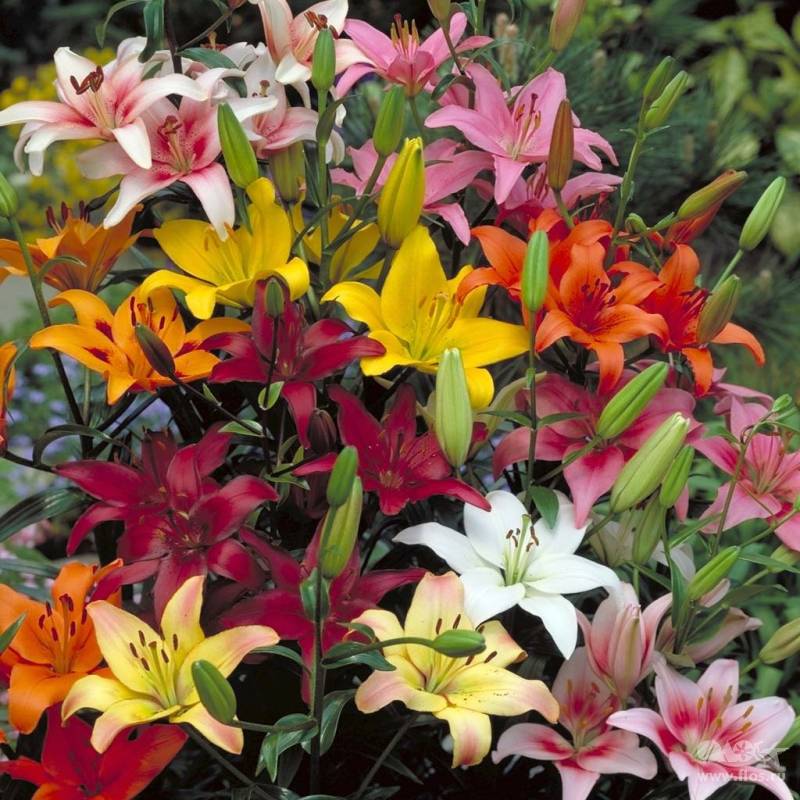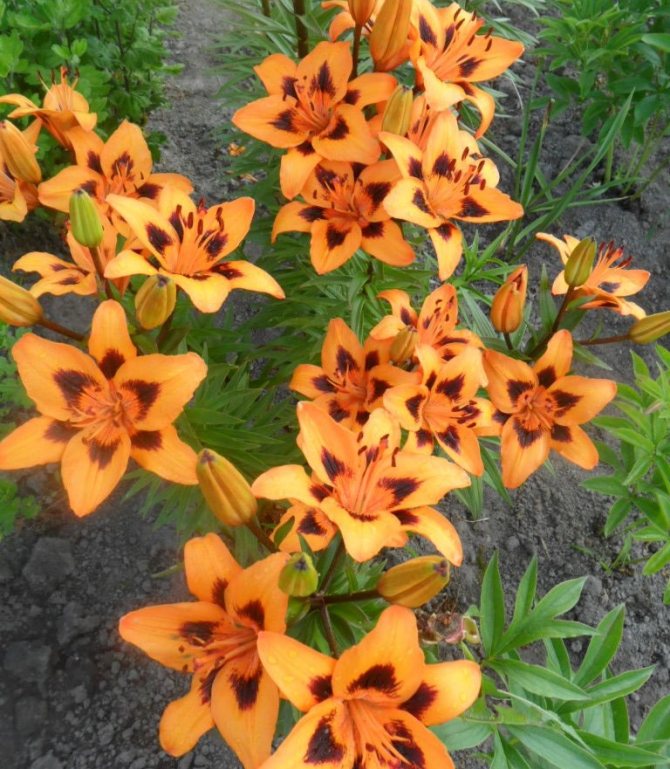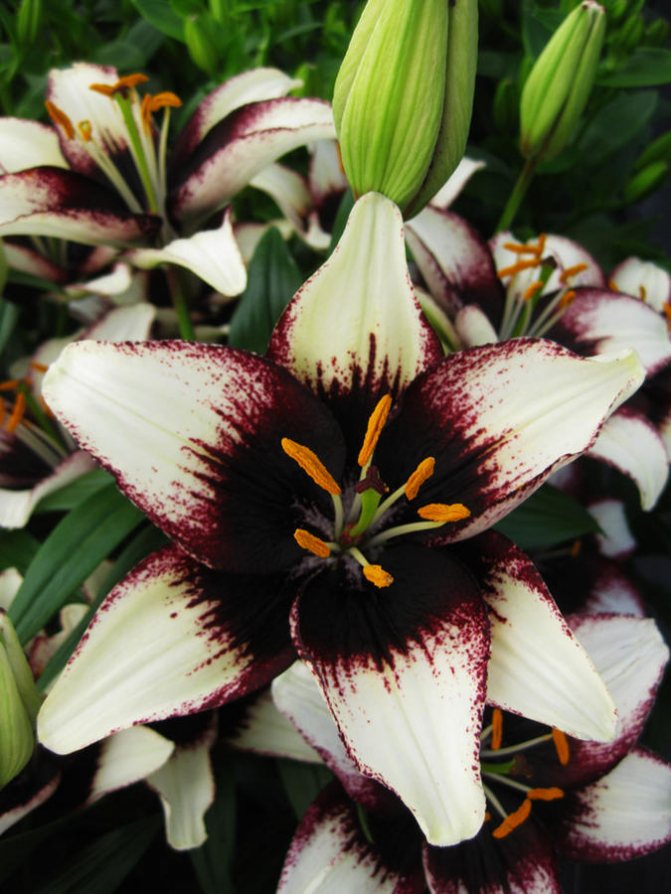The advantages of growing oriental lilies in their summer cottage gardeners include flowers of incredible beauty with a variety of colors and an intoxicating aroma. It is difficult to imagine the second half of summer at their summer cottage without these beauties. Thanks to the works of breeders, many varieties of oriental, or oriental hybrids have appeared, which are adapted for growing in the difficult climate of central Russia. With proper agricultural technology, plants do not get sick and reward gardeners with huge buds of incredible beauty.
General description and characteristics of oriental lilies
Oriental lily has broad-lanceolate leaves located on long petioles. Their inflorescences are spreading, racemose, flowers can be directed downward or sideways. The shape of the flowers is turbid, tubular or star-shaped. The shade of the petals is crimson, white, pink.
A special feature of oriental hybrids is a long growing season, so they need a long warm summer. In the middle lane, cultivation is possible, but it will require a mandatory shelter for the winter.
The Asiatic Hybrids
These include the most unpretentious, winter-hardy plants. The flowers of these lilies are odorless and have a wide range of colors. “Asians” are grouped by color and petal painting: brushmark, polychrome (two- and three-color), tango (with thick contrasting speck), Connecticut (speckless).
A dense contrasting speck is characteristic of the "tango" cultivar group. Lily ‘Apicot Pixels’
If the perianth lobes ("petals") of the varieties are decorated with strokes, this is a brushmark (‘ Delta ’ , ‘ Loretto ’ , ‘ Baja ’ ).
'Corrida' - cultivar with polychrome flower color In some cultivars they are marked with shading (
‘ Centerfold ’ ), have a polychrome - two- or three-color - color (‘ Corrida ’ , ‘ Tinos ’ ,‘ Gran Cru ' , ‘ Vermeer '), dense speck (‘ Apricot Pixel ’ , ‘ Tropical Breeze ’ , ‘White Pixels’, ‘ Wizard ’ ). Variety 'Aelita' - star-shaped flowers
Depending on the variety, Asian hybrids are turbid (‘ Citronella ’ ), star (‘ Aelita ’ ), cupped (‘ Paola ’ ) flower shape.
The ‘Citronella’ variety has turbid flowers
A rare speck, an elegant turban-shaped flower shape, high growth distinguishes the group of lilies L ilium lancifolium, represented by varieties ‘Sweet Surrender’ , ‘ Pink Giant ’ , ‘ King Pete ’ , ‘ Red Tiger ’ , ‘ Salmon Tiger ’ , ‘ White Tiger ’ .
Lilium lancifolium, showy 'Sweet Surrender'
The palette of shades is very wide:
- pure white with a greenish core ‘Apollo’, ‘Sorpresa’, ‘Pulsar’;
‘Apollo’ (Asian hybrids)
- yellow, various shades in ‘GoldenFlame’, with a delicate speck at the base - ‘Gironde’;
'Gironde' (Asian hybrids)
- pure orange color ‘KlaasDeJond’;
- tangerine red with fiery reflections at ‘Saidja’;
‘Saidja’ (Asian hybrids)
- deep pink with shades of lilac ‘Paola’;
'Paola' (Asian hybrids)
- red with purple and dark specks in the middle ‘Marrakech’;
- dark red, purple y ‘BlackOut’;
‘Black Out’ (Asian hybrids)
- the darkest color of the "magic" black-purple ‘Landini’.
‘Landini’ (Asian hybrids)
There are several varieties with double flowers in this group. They are not very popular among flower growers, because with an increase in the number of "petals", the ideal shape is lost, the flower looks sloppy, shaggy (‘ Ceres ’ , ‘ Elodie ’ , ‘ Aphrodite ’ , ‘ Fata Morgana ’ other).
Double flowers lose their ideal shape. ‘Ceres’ variety
Lily is amazing and unusual ‘ Marlen ’ , the varietal trait of which is frequently appearing fasciation, i.e. accretion of several stems into one flattened, and, accordingly, extraordinary flowering.
This is what a 'Marlen' fascia lily looks like
Asian hybrids are easily propagated by daughter bulbs, scales, bulbs (‘Aelita’, 'Accent', 'Firebird' other). They are undemanding to the soil, prefer loose, slightly acidic or neutral. Location - sunny or partial shade.
You will find a large selection of lily bulbs of Asian hybrids in our catalog, which contains the offers of many large garden online stores. Select lily bulbs.
Types and varieties of culture
Among the hybrids and varieties of oriental lilies, the following are especially popular with gardeners:
- Oriental. Reaches a meter in height, therefore it is included in the category of large species. On its petals on the inside, the color is yellow-white, and the outside is dotted with dots and small pimples. The Oriental Lily blooms in July or August and exudes a pronounced pleasant aroma.
- Asterion. The height of the hybrid ranges from 40 to 120 cm. In the blossoming state, the diameter of the buds reaches 22-23 cm. The petals have a creamy white hue and slight waviness. Up to 3 buds grow on one peduncle at the same time.
- Time Out. Of all the hybrids of oriental lilies, this one is the most unpretentious. The flowers are medium in size (18-20 cm in diameter), with extended petals on which there are longitudinal yellow stripes. It develops in height up to 120 cm, the flowering period begins in mid-August.
- Star Class. The height of the hybrid is up to 110 cm. It is characterized by flowers 20 cm in diameter, which have a white center and pink edges of the petals.
See also
Description and characteristics of varieties of bush lilies, planting and care in the open fieldRead
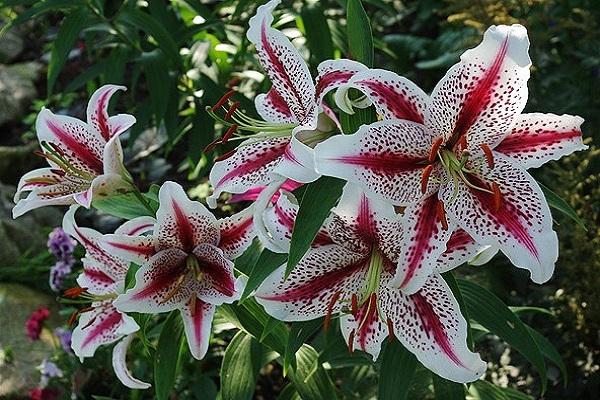
Lilies undersized: varieties + photos
Among Asian hybrids, there are many low-growing varieties that can be successfully grown in small pots on terraces, balconies and even indoors. All of them do not grow more than 50-60 cm, and many varieties reach only 40 cm.
It is these lily varieties that have been called by some unscrupulous sellers as the newest varieties of "pot" or pot lilies. In fact, many of them have been known for quite some time, and by planting several bulbs of different varieties in a pot, you can really soon get a luxurious bouquet of small multi-colored lilies.
But the flowering of this bouquet will last for a relatively short time - no more than two weeks. If you want to enjoy flowering longer, about a month, then you can use low-growing varieties of lilies from the group of oriental hybrids for these purposes, which will be discussed below.
Advice! If you see the words "Pixie" or "Tiny" in the name of the lily variety, then this means that in front of you is a flower that belongs to undersized Asian hybrids.
What other undersized varieties are:
- Belem
- Buzzer
- Sorokaba
- Spider
- Curitiba
- Ivory Pixie
- Juan Pesao
- Rio de Janeiro
- Lady like
- Matrix
- Tiny Chost
Pros and cons
Before planting oriental beauties, be sure to study their strengths and weaknesses in order to avoid mistakes in the growing process.
The advantages of lilies include:
- Spectacular appearance.
- Bright pleasant smell.
- They look good in the cut.
- Large selection of hybrids with different petal colors.
Of the disadvantages, attention is paid to the following:
- Long growing season.
- Late flowering period.
- The need for additional insulation for the winter.


The nuances of growing a plant
When starting to grow a capricious and thermophilic plant, they pay attention to its requirements for the location and characteristics of the soil.
Pick up time and place
It is recommended to plant oriental lilies in the spring, when the weather is stable and warm without the risk of recurrent frosts. This will enable young flowers to take root in a new place and strengthen immunity before the onset of cold weather.
Since oriental beauties are mostly tall, a place for them is chosen protected from strong gusts of wind that can break the delicate flower.
An area with light shading is ideal; in the open scorching sun, the petals fade and lose their decorative effect.
The soil
The soil must be fertile, with a slightly acidic reaction. Peaty soil with little deciduous humus and sand is a good choice. At the bottom, drainage must be arranged, otherwise the bulbs become infected with fusarium and die.
Planting bulbs
Before planting, the bulbs are treated with any fungicide to protect the plants from fungal diseases. In the prepared soil, small holes are made at a distance of at least 20 cm from each other. Shorter planting spacing will cause flowers to compete for nutrients.


The bulbs are slightly buried, sprinkled on top with a small layer of sand and mulched with sawdust. This will prevent moisture evaporation and protect young plants from weeds.
What are Asiatic Lilies?
These flowers come from the following types of lilies, as well as their varieties:
- bulbous;
- lilies of Wilson;
- lilies of David;
- lilies of Leuchtlin;
- Daurian;
- dwarf;
- Lankong;
- callous;
- single color;
- drooping;
- pleasant;
- 12) brindle.
Like oriental lilies, Asiatic lilies are represented by plants with flowers that can be directed up, to the sides or down.
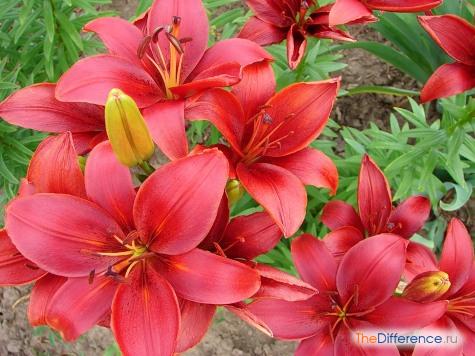

The main features of Asiatic lilies are unpretentiousness, resistance to frost. They can be grown not only in sunny places, but also in shaded areas. It is recommended to plant Asian lilies in neutral or slightly acidic soil.
The height of Asiatic lilies is 50-150 cm. The size of their flowers can reach 20 cm. The color of flowers of Asiatic lilies is very diverse. Both white and very dark flowers can appear. Orange, apricot, red Asiatic lilies are popular. There are also two-color varieties of flowers.
Like oriental lilies, Asiatic lilies are often grown as houseplants.
How to properly care for flowers
Outdoor care for oriental lilies is carried out regularly, as the flower is delicate and capricious.
Watering and feeding
Moistening the soil on which oriental lilies grow is carried out in moderation. Flowers do not tolerate excessive moisture and react to it by reducing the decorative appearance and rotting of the bulbs. In cloudy weather, watering is not carried out at all; in extreme heat, it is moderately irrigated once a week.
See also
Is it necessary to dig lilies for the winter, preparing a shelter, when to cut and how to storeRead
Top dressing is an indispensable component of the care of oriental hybrids. For these purposes, it is better to purchase special fertilizers for bulbous plants in a gardening store and, when using, follow the instructions on the package.
It is strictly forbidden to use fresh manure for feeding lilies. It becomes the cause of the development of diseases.
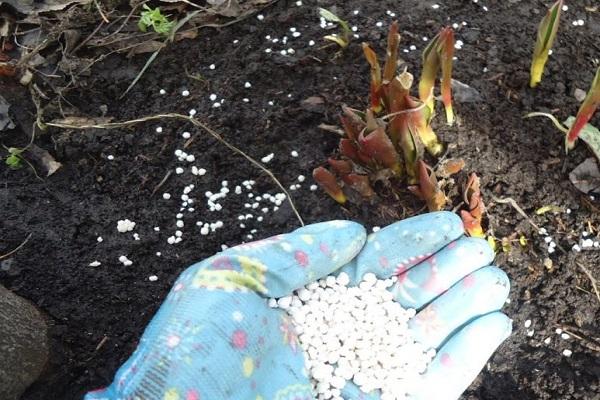

Shelter for the winter
Be sure to insulate delicate flowers before the onset of cold weather. Cut the peduncle to a 10-centimeter hemp and pour a bucket of earth on top. Fallen dry leaves are laid on top of it. In regions with severe frosts, it is advisable to cover the top with roofing material.
Growing at home
Growing Asian hybrids in a flower bed near your home is a snap. Unpretentious flowers do not need special care and conditions. It is enough just to choose a suitable place for planting, fertilize and replant the bulbs in time.
Choosing a landing site
Lilies are perennial plants. Therefore, you need to plant the bulbs immediately in a permanent place where they can grow for 3-4 years. After this period, the flower-bearing stems usually become shorter, and there are fewer flowers on them.
Several small stems can grow near the main stem, which signal that many new bulbs have formed, and they are cramped in the nest. All this means that it is time to dig up, divide and transplant the bulbs to a new place. If this is not done, then the bush will most likely get sick and disappear. For Asians, you need to choose a well-lit area, partial shade is allowed. With a lack of sun, the stems will stretch towards the light and bend. Ideally, the buds are in the sun, and the lower part of the plant is in the shade. This can be achieved by covering the ground with a thick layer of mulch that will retain moisture. You can also plant undersized neighbors next to the lily bushes, which will create shade for the roots.
The advantage of Asian hybrids is their winter hardiness. They are not afraid of cold or frost. Therefore, there is no need to dig up the bulbs for the winter. In a snowy winter, there is no need to cover them either. If winter did not bring snow with it, then it is advisable to cover the bushes with mulch.
Soil and fertilizers
Although Asian women are unpretentious, they do not like lime soil. Neutral or slightly acidic earth is suitable for them (pH 6–6.5). Suitable soil composition:, loam, leaf humus, (but not fresh), etc.
Before planting, it is advisable to pour sand into each hole, which will act as drainage and absorb excess moisture. Before planting the bulbs, you can saturate the soil with mineral fertilizers, but without nitrogen. Potassium nitrate solution is often used for feeding.
You need to feed lilies 2-3 times a month, starting from the second week after planting. Feeding becomes especially important during the formation of buds. But during the flowering period, you should not feed, otherwise this process will accelerate.
Important!
Asian lilies do not like fresh organic fertilizers (manure) and excess nitrogen.
Watering and moisture
Asiatic lily easily withstands temporary drying out of the soil and does not tolerate stagnant water, due to which it can get sick. For an Asian woman, it is better not to finish drinking than to drink too much. On the other hand, constant drying out is also undesirable: the plant becomes weak, loses in growth, and the flowers become less beautiful. The best soil condition is moderate moisture. This will help, as already mentioned, mulching or planting low-growing perennials between lilies to create shade over the roots and prevent them from drying out. You need to water abundantly and as the soil dries.
In dry weather, this should be done once a week. It is advisable to water it at the root in the first half of the day, so that by night the earth on top has time to dry out. After the cessation of flowering, watering should also be stopped. The only exception can be a very hot autumn.
Reproduction
Asiatic lilies can be propagated in four ways. The first three are related to the bulb. The fourth way is propagation by stem bulbs. Let's consider each of them in more detail.
Bulb
Video: reproduction of lilies by scales
Stem buds (bulbs)
Among Asian hybrids, there are varieties that multiply by bulbous growing on stems. They look like bulbs that form small leaf scales.
They themselves fall off the mother plants, put down roots and germinate. They need to be collected on time and planted in the right place in the same way as root bulbs. New lilies will bloom only after two years.
Planting lilies
For planting, you need to take high-quality planting material. Only in this case will you get healthy and beautiful flowers. The bulbs must be firm, free from damage or other visual defects.
For disinfection, they should be treated with a solution of karbofos or foundationol. For storage, the bulbs should be left in a dark and cool room and covered with moss, sawdust or a damp cloth.
Important!
The flowering time depends on the size of the planting bulb.A bush that grows from a large bulb will bloom in the first year, and from a small bulb in the second.
When to plant lilies
You can plant lilies at any time of the year, except for winter. But still the preferred planting seasons are spring and autumn. Asians often land in the ground in March, after the snow has melted.
Spring planting benefits:
- in the ground, the bulbs will not get wet and will not freeze;
- they take root and take root better.
Many gardeners prefer autumn planting of lilies. The roots have time to develop enough to survive the winter. Even severe frosts are not terrible if the planted bulbs are covered.
Planting lilies in spring
When planting lilies, you need to remember the rule: the larger the bulb, the deeper it needs to be planted, and the deeper it sits in the ground, the later it will bloom. The depth of the hole also depends on the height of the future plant: for low varieties, a hole is prepared with a depth of about 10 cm, for medium varieties - about 15 cm, and for tall bushes - 20 cm.
Video: how to plant lilies in spring
Prepared holes or trenches of the desired length can be fertilized with humus or compost. The bottom of the hole is covered with sand, a bulb is carefully placed on it, and the top is covered first with sand, and then with earth. The planting site is thoroughly watered, and then mulched with peat or sawdust (5 cm layer).
Planting lilies in the fall
Purchased bulbs are planted in the fall according to the same principle as in the spring. But most often in the autumn, they divide and plant already growing bushes in the ways described above: children, bulbs and scales are planted in the ground.
Three- and four-year-old plants especially need this. The transplant can be carried out without waiting for autumn, 1–1.5 months after the end of flowering. Many Asian varieties can be planted as early as August.
Video: planting lilies
Lily care
Taking care of lilies, especially Asian lilies, is not difficult. We have already discussed the main points: regular watering, proper feeding and timely transplantation. You also need to be prepared for possible difficulties.
How to care for lilies in the garden
Unlike other hybrid groups, the Asiatic lily is not afraid of winter. Severe frosts are not terrible for her, especially if the beds are covered with snow or mulch. There is no need to dig up the bulbs before the onset of cold weather.
But if the bulbs are still dug or bought, and it is still a long time before planting time, then they need to provide the correct storage conditions. The air in the storage should not be very dry or very humid, cold but not frosty. The room must be well ventilated. A basement, a loggia or even a refrigerator can serve as such storage. Before taking the planting material to the storage place, it must be placed in a container (box, box, bag), laying out the bulbs in layers and sprinkling them with peat.
To prevent the contents of the box from drying out, you need to spray it with water from time to time. This way, the bulbs will stay in good condition and wait in the wings.
Possible difficulties in growing lilies
Difficulties rarely arise with the cultivation of Asian women, but still there are. Let's discuss their reasons and methods of struggle.
- The flowers fade quickly.
Possible reasons: the soil is very wet and water stagnates in the roots, or, conversely, the soil and roots overheat. Plants can be saved from overheating with mulch (sawdust, grass, straw), which will reflect sunlight. - Bushes often get sick.
Reason: fertilization with fresh manure, which can be a source of harmful bacteria. Lilies cannot tolerate fresh organic fertilizers. You can use well-rotted compost or humus, which is at least 4 years old.
Video: growing, care and reproduction of lilies
Pests, diseases and prevention
Lilies after flowering
After the end of flowering, you need to remove the seed pods, if there is no need to collect the seeds. And the stems with leaves remain standing until they turn yellow and wither.If the weather is hot, then you need to continue to water the plants, as they supply their bulbs with the necessary nutrition.
Video: caring for lilies after flowering
In the fall, the bush is cut off. The lilies can then be transplanted. Before the onset of frost, the bulbs should be covered with mulch. Cut bushes are not suitable for compost.
Oriental lilies create a unique luxury and envelop the garden with a heady aroma. Their huge bell-shaped inflorescences are several times larger than those of species or tiger lilies, and their bright colors with a characteristic speck make them the most recognizable among other groups of lilies. Oriental lilies - luxury and splendor in the garden.
Varieties of oriental lilies
Oriental lilies became famous for one of the most spectacular varieties - Stargazer
... It was this variety that appeared first in the gardens. It is still one of the most stable in the conditions of the Moscow region. Snow white
Siberia
and
Muscadet
with light specks are also unpretentious.
Photo: variety of oriental lily Stargazer
Interesting red and burgundy varieties of oriental lilies, when buying them, you need to carefully examine the planting material - such bulbs dry very quickly. The varieties look spectacular Play Time
,
Tiger Edition
,
Tiger Woods
,
Solution
,
Dizzy
and
Spectator
... Their inflorescences have pronounced colored stripes in the center of the petals, combined with a catchy speck. Unfortunately, an interesting variety lily
Tiger Edition
unstable in the conditions of the Moscow region.
Among the oriental lilies there are also potted varieties - they look quite unusual and at the same time are stable in culture.
Photo: oriental lily variety Fabiola
Terry oriental lilies are especially splendid, including: Seren Angel
,
May Wedding
,
Fabiola
,
Magic Star
other. It is interesting to watch how every day the plants dissolve the next row of petals.
Photo: variety of oriental lily Magic Star
Terry lilies, unlike varieties with a simple flower shape, need twice as much strength to fully open their numerous petals. In addition to nutritious soil, they need additional feeding in May and June. They need to be transplanted every two years.
Additionally, photos and descriptions of other varieties of lilies in the articles:
Lily planting site
According to their requirements for agricultural technology, oriental lilies keep some aloof, preferring. It is advisable to plant them in the sun or in light partial shade in such a way that the chosen place is well ventilated.
Oriental lilies are susceptible to fungal diseases, so you should not plant them in between. They will be great at the foot, in the background, along or in the foreground. Landing from the edge is possible.
Oriental lilies need super-nutritious soil for powerful flowering. Plants consume the entire set of nutrients in two years, completely depleting the soil, so lilies need frequent transplantation: every 2 - 3 years.
Soil for planting lilies
Good soil is the key to successful cultivation of oriental lilies. I prepare it like this: I sift it through a large-mesh box, and I do the same with the fertile one. I do not add ash or lime. With scissors I cut sphagnum and last year's perennial stems into small fragments. I mix the moss with the soil, and put the stalks of perennials in a layer of 5 cm on the bottom of a plastic box. Oriental lilies prefer loose, breathable soil. Moss and chopped stems or straw help to get the desired structure.
I plant all lilies, including oriental ones, in boxes - they serve as protection from mice. The use of boxes is also convenient during transplantation, when the bulbs are in the same container with the children.
Additionally about the features of planting and caring for lilies:
Shelter lilies for the winter
Oriental lilies with a simple flower shape in the Moscow region need light shelter for the winter.It is enough to pour a bucket of dry earth onto the landing site and cover it with roofing material or plywood on top.
Terry oriental lilies are less winter-hardy. An excellent solution for them would be planting under a common shelter with roses, for example. If this is not possible, then cover the poured earth with leaves, and then with the same plywood so that the shelter does not get wet.
Reproduction of oriental lilies
Contrary to popular belief that oriental lilies are extremely reluctant to breed and do not give children, this is not the case. In fertile soil in the suburbs of Moscow, lilies form babies on top of the main bulb in the second year. In addition, in the third year after planting, the lily bulb forms an equivalent bulb of the same kind. When transplanted, they are well separated from each other.
You need to plant lilies immediately after digging so that the roots do not dry out - oriental lilies are quite capricious in this matter. They begin to transplant at the beginning of September - this is the only time when they are engaged in the reproduction of lilies. The fact is that immediately after flowering, the lily bulb is very fragile, and even with careful digging, the scales break off on it. In order not to harm the oriental beauties, after flowering, no manipulations are carried out over them for a month.
Svetlana Samoilova, amateur florist, collector of rare plants
Read more about the technology of planting flower bulbs in the article:
Such lilies have inflorescences reaching thirty-one centimeters in diameter. Oriental lily hybrids look great in cut, cultivation does not require certain skills and special secrets. Today, an oriental lily is presented, varieties of lilies, photos, names and descriptions.
Diseases and pests
Of the fungal diseases, gray rot and fusarium are considered the most dangerous for oriental beauties. They develop in damp and cold weather, as well as when lilies are excessively hydrated. For treatment, fungicidal preparations containing copper are used.
If the plants are infected with viral diseases, the flowers will have to be destroyed so as not to endanger other crops on the site. Among the most dangerous are the tobacco and cucumber mosaic virus. There is no cure.
Among pests, mice and other rodents are dangerous, which love to feast on nutritious lily bulbs. Poison is scattered around the plantings in winter, and snow is trampled from time to time.


Sometimes flowers are attacked by lily flies, squeak beetle, bears and spider mites. They resort to the help of insecticides - "Karbofos", "Intavir", "Decis".
Reproduction of oriental lilies
Oriental beauties are bred in several ways:
- Seeds. The method is not suitable for all varieties and hybrids, therefore it is not popular with gardeners.
- Scales. Several scales are separated from a large healthy bulb, which are placed in a bag filled with sand, peat and coniferous litter. They are waiting for the appearance of children, periodically moistening the substrate and airing the scales. Then they are planted in open ground, at first they are covered.
- By dividing the bulb. The procedure is carried out after the end of flowering, young specimens are immediately sent to the beds, they are well insulated for the winter.




